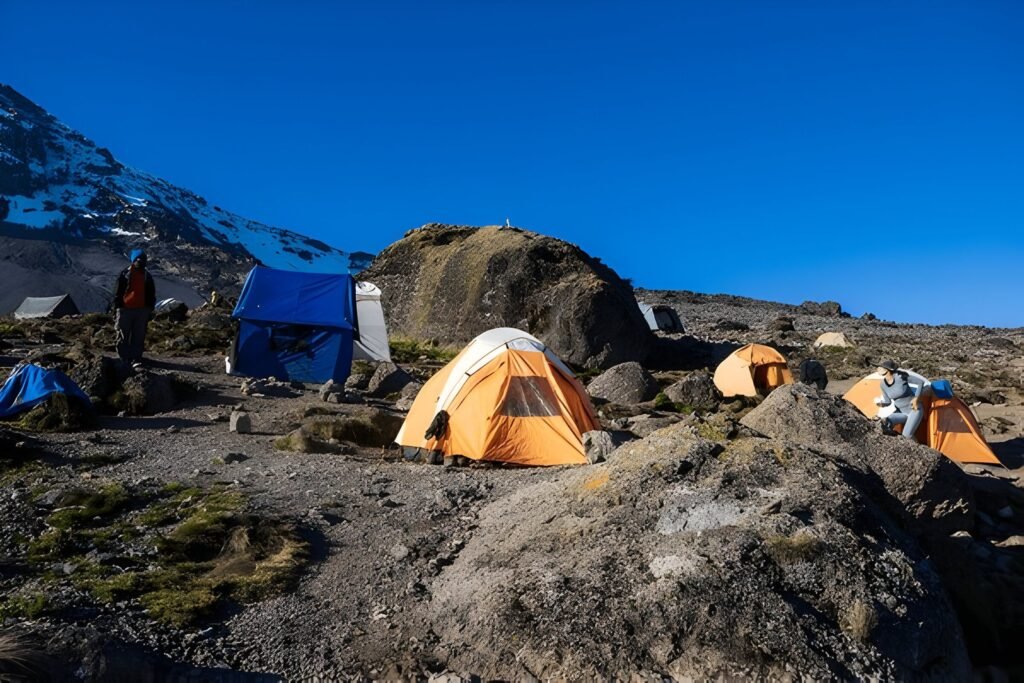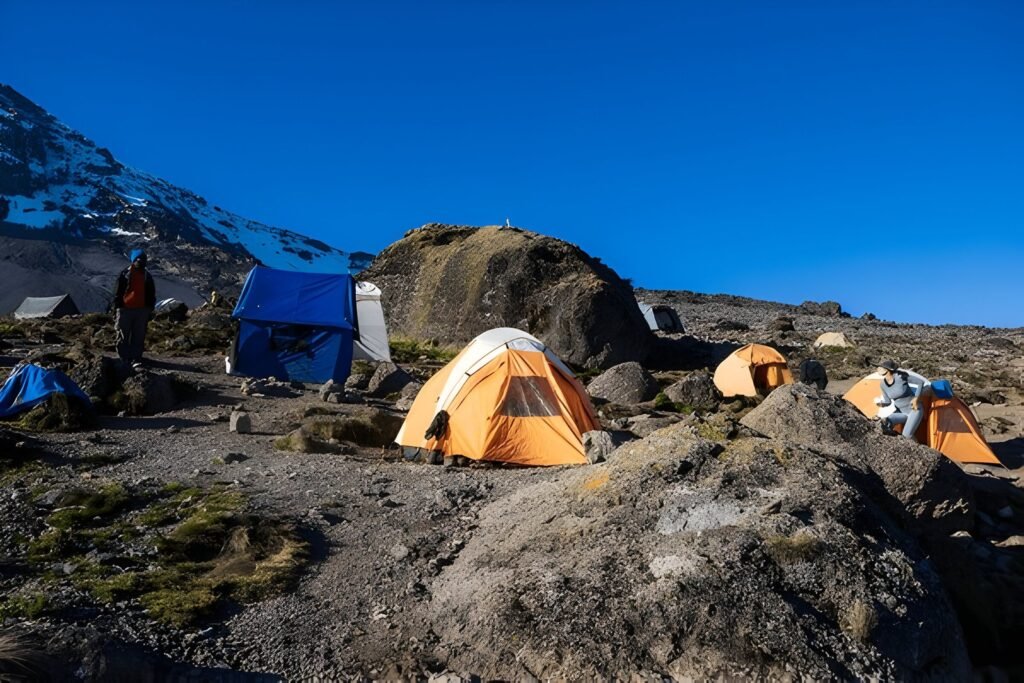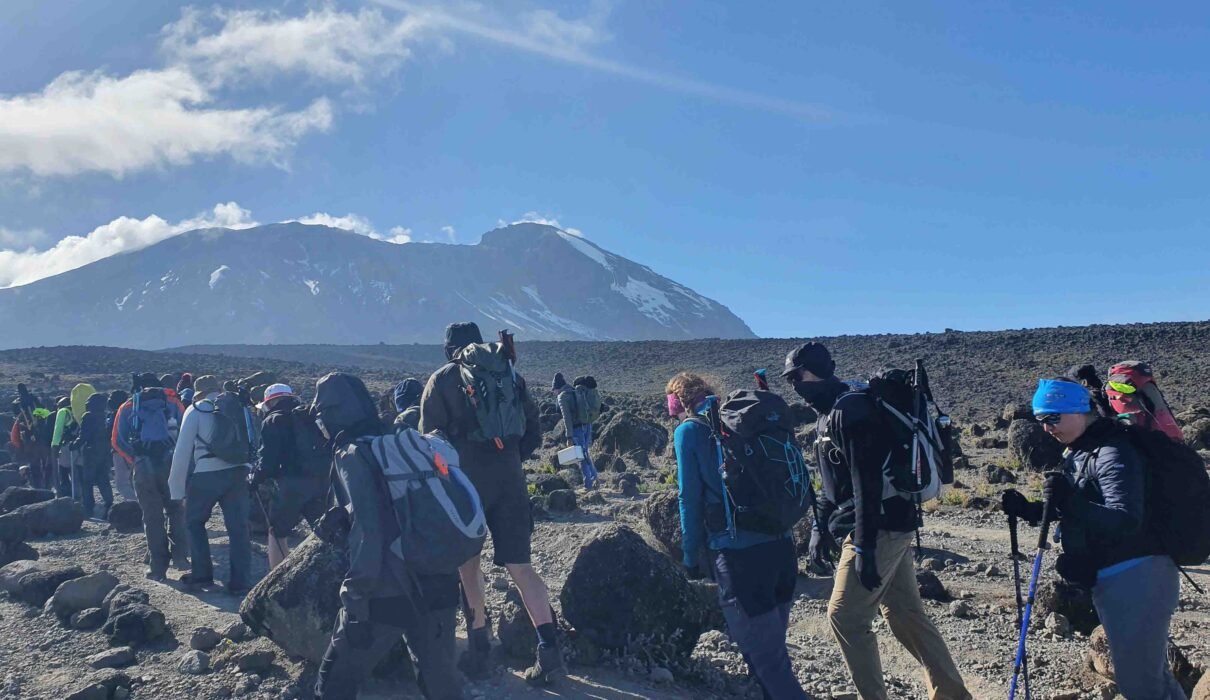What Can I Do While at Camp on Kilimanjaro ? Climbing Mount Kilimanjaro is a thrilling adventure, but the time spent at camp during the trek is just as important for a successful summit. At various camps along the route, you’ll have the opportunity to rest, acclimatize, and prepare for the next day’s challenge. In this guide, we’ll explore what you can do at camp on Kilimanjaro to stay energized, improve your chances of reaching the summit, and enjoy the overall experience
Learn more about Kilimanjaro trekking experiences here.

What Can I Do While at Camp on Kilimanjaro ? – Acclimatization: Why It’s Crucial for Success
One of the key activities at Kilimanjaro camps is acclimatizing to the increasing altitude. As you ascend, your body needs time to adjust to the thinning air. Acclimatization is crucial to preventing altitude sickness, which can derail your summit attempt
Acclimatization Tips:
- Walk High, Sleep Low: Some routes allow you to hike to a higher elevation during the day and return to camp for a lower-altitude sleep, helping your body adjust.
- Stay Hydrated: Drink plenty of water to help your body adapt to the altitude.
- Rest Well: Proper rest at camp will give your body the recovery time it needs.
Find out more about the importance of acclimatization on Kilimanjaro here.
What Can I Do While at Camp on Kilimanjaro ? – Relax and Recharge: Importance of Resting at Camp
Resting at camp on Kilimanjaro is essential for your body to recover from the day’s exertion and prepare for the next leg of the journey. Each camp offers a peaceful, natural environment where you can unwind, surrounded by stunning mountain scenery
How to Make the Most of Rest Time:
- Enjoy the Views: Kilimanjaro camps are often located in breathtaking spots, offering spectacular views of the surrounding landscapes.
- Sleep Soundly: Pack a comfortable sleeping bag and an inflatable pillow for a good night’s sleep
Read more on how to get a good night’s sleep at high altitudes.
What Can I Do While at Camp on Kilimanjaro ? : Socialize with Fellow Climbers
The communal atmosphere at Kilimanjaro camps is a highlight of the climb. You’ll share meals, stories, and experiences with fellow trekkers, creating bonds that can last a lifetime. These moments of connection add to the overall experience of conquering Kilimanjaro
- Group Games: Many groups pass the time playing card games or simply chatting by the campfire.
- Exchange Stories: Hearing others’ experiences can inspire and motivate you for the challenges ahead.
Find out more about the camaraderie on Kilimanjaro here
What Can I Do While at Camp on Kilimanjaro ? : Eat and Stay Energized with Delicious Meals
Mealtimes at camp are important for fueling your body and keeping your energy levels high. The meals are typically prepared by your trek team’s cook, and despite being on a mountain, the food is often hearty, nutritious, and surprisingly delicious
Typical Meals Include:
- Breakfast: Eggs, porridge, fruit, and bread.
- Lunch and Dinner: Pasta, rice, vegetables, and proteins like chicken or beef stew.
- Snacks: Fruit, energy bars, and nuts to keep you going between meals
Learn more about Kilimanjaro meal planning and nutrition here.
What Can I Do While at Camp on Kilimanjaro ? : Capture Stunning Photos of Kilimanjaro’s Landscapes
One of the best things you can do at camp is take time to capture the stunning beauty of Kilimanjaro’s landscapes. From vast plains below to the snow-capped summit above, each camp offers unique photo opportunities that will help you remember your journey forever
- Golden Hour Photography: Sunrise and sunset offer the most dramatic lighting for capturing the mountain and surrounding scenery.
- Nighttime Photography: The high altitude and clear skies at camp make Kilimanjaro one of the best places to capture breathtaking views of the stars.
Get photography tips for your Kilimanjaro trek here.
What Can I Do While at Camp on Kilimanjaro ? – Enjoy Stargazing in the Clear Kilimanjaro Sky
At higher altitudes, far from city lights, Kilimanjaro’s camps offer some of the most stunning stargazing experiences you’ll ever encounter. The clear night sky is filled with stars, making it the perfect way to wind down after a long day of trekking.
- Best Time for Stargazing: The night skies are clearest during the dry season (June to October, and January to February).
- What to Look For: Spot constellations, shooting stars, and planets from your camp
Discover more about stargazing on Kilimanjaro here.
What Can I Do While at Camp on Kilimanjaro ? – Mental Preparation for the Summit Push
As you rest at camp, you can mentally prepare for the challenging days ahead. Especially at higher camps like Barafu or Kibo, where the final push to the summit begins, it’s important to visualize your success and stay focused
- Meditation and Breathing: Many climbers use deep breathing techniques or meditation to clear their minds and boost mental focus.
- Positive Visualization: Imagine yourself reaching the summit, which can help improve your mindset and motivation
Learn more about mental strategies for mountain climbing.

What Can I Do While at Camp on Kilimanjaro ? – Journal or Reflect on Your Journey
Many trekkers find that writing in a journal is a great way to pass time at camp and reflect on their experience. You can jot down details about the day’s trek, the people you’ve met, and your thoughts about the journey so far
- Journaling Benefits: Helps you stay focused, document your experience, and process any challenges or triumphs along the way.
- Alternative: If you prefer not to write, consider recording voice notes or videos to capture your thoughts.
Learn more about the benefits of journaling during adventures here.
Preparing Your Gear for the Next Day
Your time at camp is also a chance to organize your gear and prepare for the next day’s hike. It’s important to ensure that your backpack, clothing, and equipment are ready for the next stretch of the climb.
Essential Gear Prep Tips:
- Check Your Layers: Ensure you have the right clothing layers for the changing weather.
- Waterproof Your Gear: Make sure your bag and gear are protected from any unexpected rain or snow.
- Refill Water: Replenish your water supply and add purification tablets if necessary.
Get more gear preparation tips for Kilimanjaro here.
Study the Route Ahead
At camp, you’ll have time to study the route ahead with your guides. This is a good opportunity to ask questions about what to expect the next day, get an overview of the elevation changes, and plan your pace.
- Study Maps: Review maps of the next section of the trail with your guides.
- Ask Questions: Talk to your guide about any concerns or tips for tackling the next stage.
Discover more about Kilimanjaro’s routes and their difficulty levels here.
What Can I Do While at Camp on Kilimanjaro ? : Conclusion
Spending time at camp on Kilimanjaro is much more than just resting. From acclimatizing to capturing stunning views, socializing, and mentally preparing for the summit, these moments at camp are integral to your Kilimanjaro experience. Use this time wisely to recharge, reflect, and enjoy the journey up Africa’s tallest peak.
For more information on planning your Kilimanjaro trek, visit Kilimanjaro Climb Specialist or Eddy Tours & Safaris.

